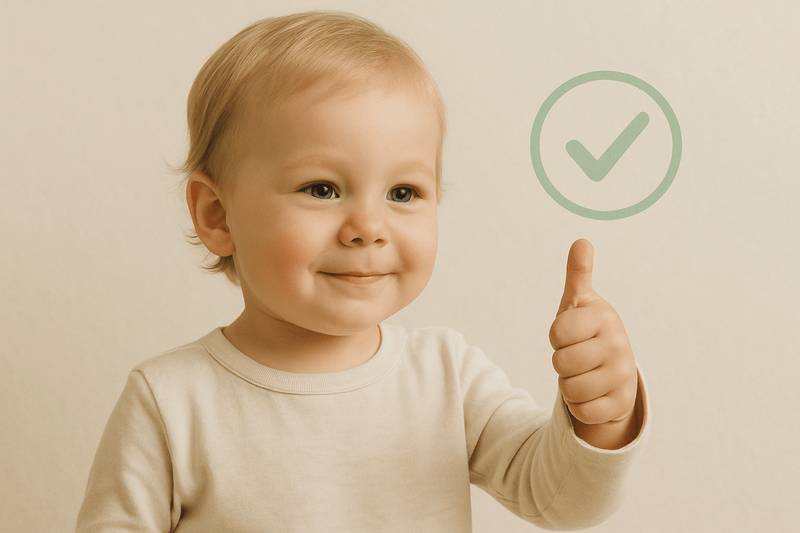Labels on Children’s Products: A Parent’s Guide

Logos and abbreviations on kids’ products can be confusing: CE, EN71, Oeko‑Tex Standard 100, GOTS, FSC, BPA Free, recycling triangles… Some are legal safety marks, others are voluntary certifications, and a few are just marketing. Here’s how to read the key labels, understand what they really cover, and make confident choices for your child.
Why labels matter
Labels signal that a product has met defined safety or chemical limits, or was made under responsible processes. For items children wear, touch and sometimes mouth (toys, textiles, drinkware), labels help you cut through claims and check what’s actually verified.
CE — baseline legal safety in the EU
CE is a mandatory conformity mark for many products sold in the EU. It indicates the manufacturer has ensured the product meets applicable EU directives (for toys, typically the Toy Safety Directive) and essential requirements for health, safety and environmental protection.
- What it covers: basic safety and regulatory compliance
- What it doesn’t: it’s not a “quality badge” or premium mark
- Tip: for toys, look for CE together with the relevant EN71 references
EN71 — toy safety standards
EN71 is a family of European standards for toys. Common parts include:
- EN71‑1 Mechanical and physical properties (small parts, sharp edges, drop tests)
- EN71‑2 Flammability
- EN71‑3 Migration of certain elements (limits for heavy metals, etc.)
If a toy is marked as tested to EN71, it has been assessed against these specific risks for the intended age group.
Oeko‑Tex Standard 100 — textiles tested for harmful substances
Oeko‑Tex Standard 100 certifies that each certified textile component (fabric, thread, prints, buttons) has been tested for a wide list of harmful substances and complies with strict limit values.
- Covers: residual chemicals (e.g., formaldehyde, certain dyes), heavy metals, and more
- Good for: baby clothing, bedding, towels, soft toys
- Tip: check the label for a certificate number you can verify on the Oeko‑Tex website
GOTS — organic textile with social and environmental criteria
GOTS (Global Organic Textile Standard) certifies organic fiber content and sets environmental + social criteria across the whole supply chain (spinning, dyeing, sewing).
- Covers: certified organic fibers, restricted inputs, wastewater, worker protections
- Good for: parents who want both organic content and audited processing
- Note: not all good textiles are GOTS; Oeko‑Tex Standard 100 also ensures safety
FSC — responsible wood and paper
FSC (Forest Stewardship Council) indicates wood or paper comes from responsibly managed forests or verified recycled sources.
- Covers: forest management and chain‑of‑custody
- Good for: wooden toys, paper packaging, furniture components
- Tip: look for FSC Mix, FSC Recycled, or FSC 100% marks
BPA Free — safer food‑contact plastics
BPA Free indicates the product is made without bisphenol A. For children’s bottles, lunch boxes and feeding accessories, this helps reduce exposure to certain endocrine‑active substances.
- Covers: absence of BPA in the stated materials
- Doesn’t mean: the item is free from all chemicals; choose reputable brands
- Tip: pair “BPA Free” with clear food‑contact suitability and brand transparency
Recycling symbols — what those triangles mean
Plastics often carry a triangle with a number indicating polymer type (e.g., 1 PET, 2 HDPE, 5 PP). This is helpful for waste sorting and gives a hint about durability, heat resistance and common recycling routes.
- 1 PET / 2 HDPE / 5 PP: commonly recycled in many regions
- 3 PVC / 6 PS / 7 Other: more difficult to recycle; check local facilities
- Tip: a triangle doesn’t guarantee local recyclability — always check your municipality’s rules
Marketing claims vs. verified certifications
Terms like “eco‑friendly”, “natural” or “non‑toxic” are not certifications by themselves. Verified labels come with public standards and, ideally, a certificate number you can check. When in doubt, look for documentation from the brand or retailer.
A quick parent checklist
- For toys: CE + relevant EN71 parts; age‑appropriate design
- For textiles: Oeko‑Tex Standard 100 and/or GOTS; colorfastness; quality stitching
- For wood/paper: FSC where applicable
- For food contact: BPA Free (or clear material disclosure), reputable brand
- For plastics: polymer code and local recycling guidance
How Kindeco uses labels
At Kindeco, labels are a starting point — not the finish line. We prioritize child‑safe materials, verified standards and real‑world durability. Our curation focuses on what kids actually touch, wear and carry daily, so families can choose confidently.
Bottom line
Labels are a practical language for parents. Understanding them helps you pick items that are safe, durable and responsibly made — not just pretty. The more you know, the easier it is to choose what truly supports your child’s well‑being.
